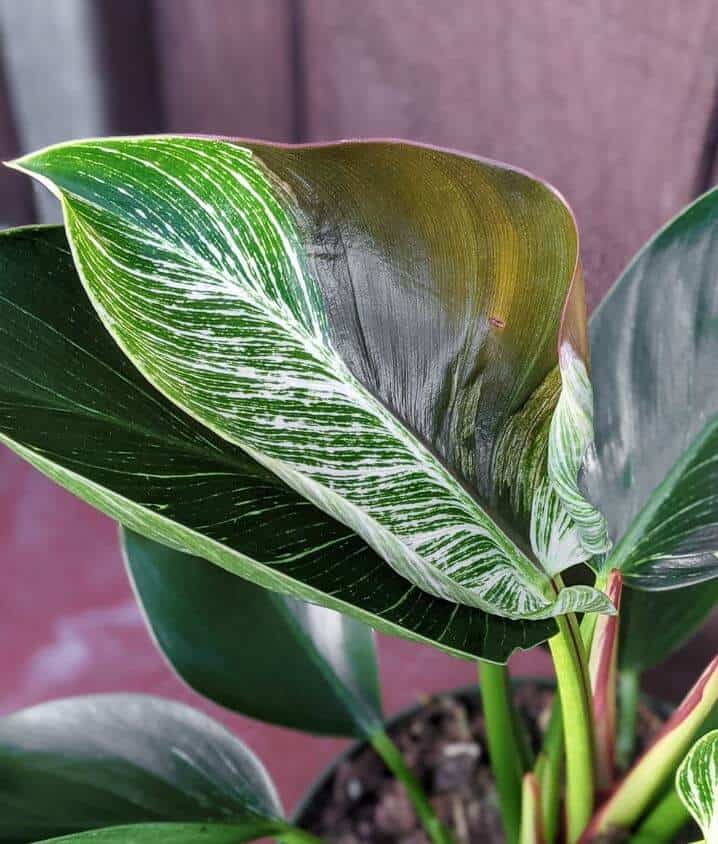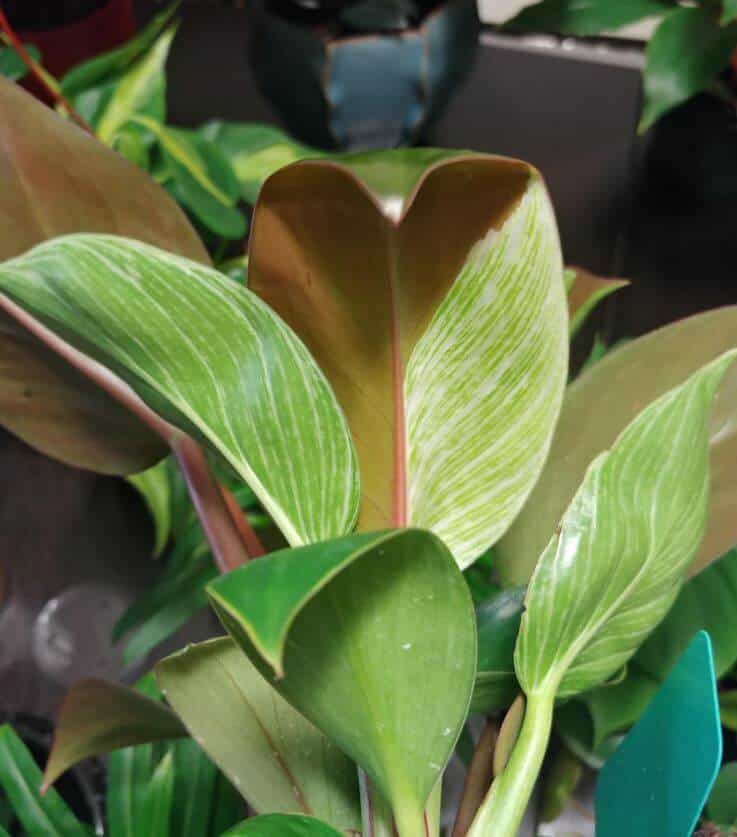Last Updated on September 9, 2023 by a Friendly Gardener
The ornamental houseplant known as the Philodendron Birkin is an aroid belonging to the Araceae family. In 1600, the philodendron was first discovered, after which almost 500 species were identified in humid tropical climates. Appreciated for their bright shiny foliage, the Birkin evolved thanks to a rare spontaneous genetic mutation in the Rojo Congo Philodendron. The Red Congo or Rojo Congo Philodendron features burgundy leaves and yet it is responsible for the cream-striped variegated Birkin philodendron.
This chimeric mutation caused foliage to develop variegations in the form of creamy white lines where plant cells are unable to produce green pigment resulting in an increased need for light. This foliage mutation was propagated, and the Birkin was born. Interestingly, the mutation is relatively unstable meaning that a Birkin can revert to a Rojo Congo philodendron with unvariegated normal leaves in green, bordeaux, or cream hues.
The Rojo Congo is a hybrid that was developed through the crossbreeding of the Philodendron ’Imperial Red’ and the Philodendron ‘Tatei’.
The Philodendron Birkin Reversion to a Philodendron Rojo Congo

The Philodendron Birkin is classified as a variegated cultivar of the Philodendron Rojo Congo or Red Congo. Birkin cultivars are also referred to as the Philodendron White Wave. Leaves within a Birkin will show varying amounts of color variegation.
The spontaneous variegation known as chimeric means that this change remains unstable and that what appeared to be a philodendron Birkin can revert to being a normal Philodendron Red Congo or you may end up with a plant with two personalities, a philodendron Rojo Congo Birkin plant which features foliage characteristic of both. Very occasionally, the reverted foliage may even revert to the Birkin variegation.
During reversion, foliage may feature reddish stems, margins, patches, or even turn entirely reddish purple with many of the Red Congo plant traits emerging and appearing to be dominant. Because these mutations are spontaneous, foliage will change randomly although it is more likely that foliage will remain variegated with optimal care.
Can Birkin Red Congo Reversion Return to Variegation?
Reversion is usually random, but you can attempt to discourage reversion and maintain variegation. Experts suggest:
- providing more bright light
- maintaining a proper watering schedule
- maintaining ideal environmental temperature
- pruning stems that are solid in color without variegation
- propagating a variegated stem cutting
- Feed your plant with a fertilizer with a low amount of nitrogen as it encourages chlorophyll and leaf growth.
Or you may opt to allow your Red Congo Birkin plant to develop two types of foliage, those with Birkin variegation and those reverting to Red Congo characteristics.
Philodendron Birkin Red Congo Plant Care

Soil
As an aroid, loose airy soil should have moisture retention but be well-draining. Aroid soil mixtures are available or blend 50% potting soil with 25% sphagnum moss for moisture retention and 25% orchid bark for drainage. A mix of two-thirds potting mix or peat and one-third perlite is also a good alternative.
Pots can be plastic, clay, or terra cotta and must come with sufficient drainage holes. Clay and terracotta pots will dry the soil bed out faster.
Light

Many tropical plants, including the philodendron Birkin Red Congo, thrive with indirect exposure to bright sunlight. Direct sunlight should be avoided to prevent scorching the leaves. If your plant has a lot of white variegation, it will need more light. Too little light may cause a loss of variegation.
Water
This Philodendron cultivar prefers moist soil. However, let it dry out a bit between its waterings. Philodendrons can survive a bit of drought much better than overwatering. Let the soil bed dry out to about an inch deep before watering anew.
Soak your plant completely when watering letting excess water drain out. Philodendrons can be bottom watered. Place it in several inches of water and let your plant soak up the amount of water it needs.
This Philodendron cultivar is not particularly sensitive to municipal tap water, however, collected rainwater or distilled water is a better option.
Humidity

Tropical plants enjoy humidity so levels of 40% or above are optimal with levels between 50% and 70% ideal.
To improve the environmental humidity:
- Place your plant in a kitchen or bathroom,
- Create a pebble water tray and position it beneath your plant,
- Group several plants near one another for shared transpiration,
- Get a space humidifier.
Temperature
These cultivars do not like the cold so indoor temperatures are generally fine. Do not place a Birkin Red Congo in a temperature below 60° Fahrenheit. Below 50° F, your plant may be harmed. Temperatures above 85°F can also be detrimental to your plant’s health. Drafts can also be problematic. Protect these cultivars from doorways, windows, and air conditioning as well as heating units and vents.
Feeding
Apply a liquid-balanced fertilizer monthly when watering. A balanced NPK 20-20-20 fertilizer diluted to half strength can be used. If variegation suffers and you want more, lower the nitrogen content in your fertilizer.
Organic fertilizer such as worm castings can also be applied but it will work slower or add 10% compost to the growing medium during repotting. Interrupt fertilization during the winter.
Pruning
These philodendrons do not require pruning. Remove dead or damaged leaves as necessary.
Repotting

As a plant with a rapid growth habit, check your plant yearly for symptoms of being rootbound. Roots peeping out of drainage holes are a sure sign. Select a pot that is no more than one or two inches larger.
Philodendron Birkin Red Congo Problems
The principal risks of infection or disease come from overwatering. The most frequent issue is root rot from poor drainage, overwatering, or an overly large container. Stunted growth, wilting, or yellowing leaves are typical symptoms. Roots may appear black and mushy.
Remove the plant from its pot and trim away infected roots. Rinse remaining healthy roots and repot in fresh soil and perlite. Wait before watering again and adjust the watering schedule.
Overwatering also causes Xanthomonas commonly referred to as Bacterial Leaf Spot. Symptoms include dark spots with yellow halos on foliage.
Bacterial Blight or Erwinia is another risk. Dark spots spread quickly on leaves. It can be fatal when left untreated.
Potential pest infestations include spider mites that will eat foliage ruining it. Remove them with a water spray. Trim off affected leaves and treat with insecticidal soap.
Small yellow or black insects known as thrips can negatively affect leaves leaving them pale and splotchy. Prune affected leaves and treat them with insecticidal soap or horticultural neem oil.
Scale insects appear as brown waxy bumps on leaves or stem. Mealybugs appear as white cottony deposits. Remove both manually and treat with insecticidal soap or horticultural oil.
Philodendron Toxicity and Pets
The ASPCA – American Society for the Prevention of Cruelty to Animals reports that Philodendron species as poisonous to family pets as they contain calcium oxalate crystals. If enough plant parts are eaten, ingestion can be fatal. If you note ingestion, rinse the skin or mouth immediately. Should swelling develop, contact a veterinarian. For severe symptoms, rush your pet to emergency treatment.

